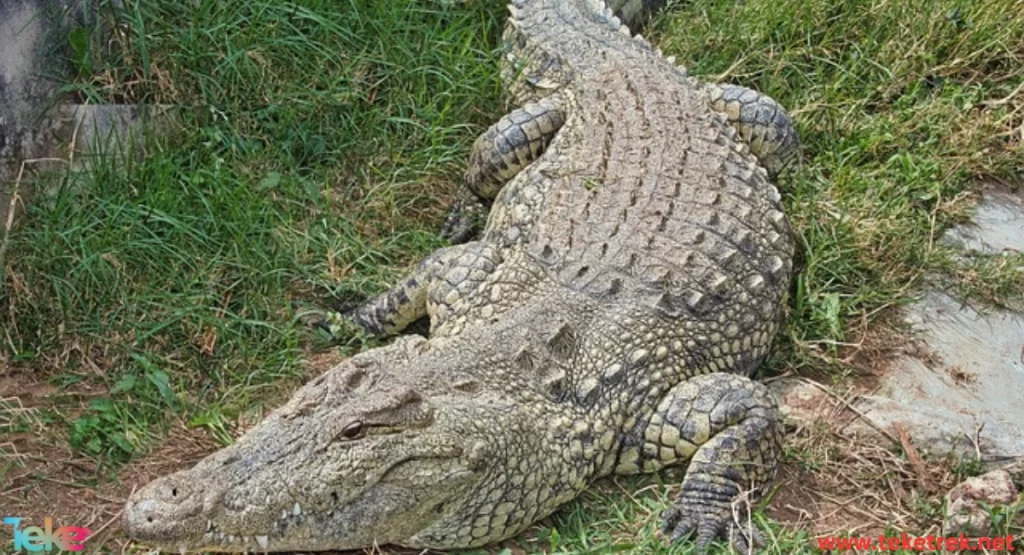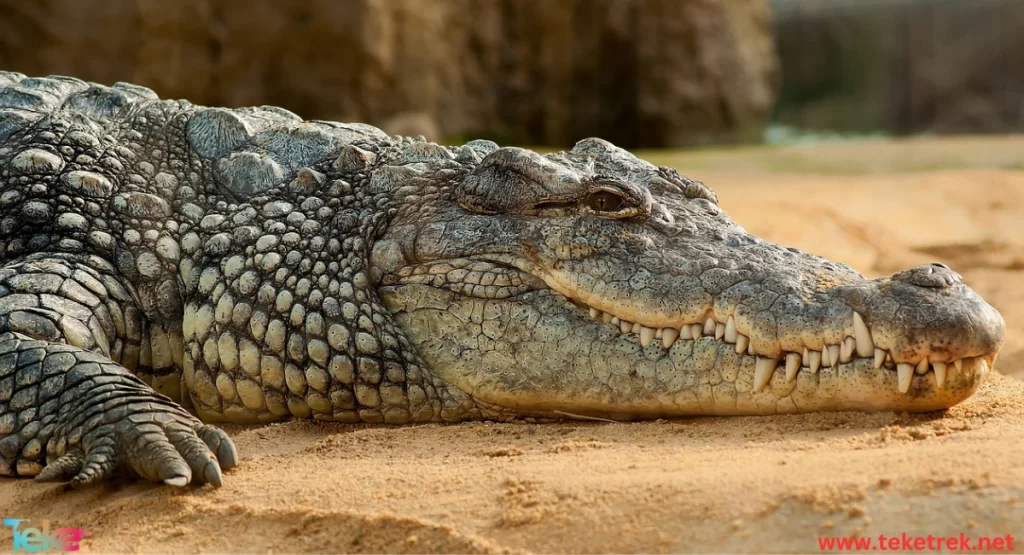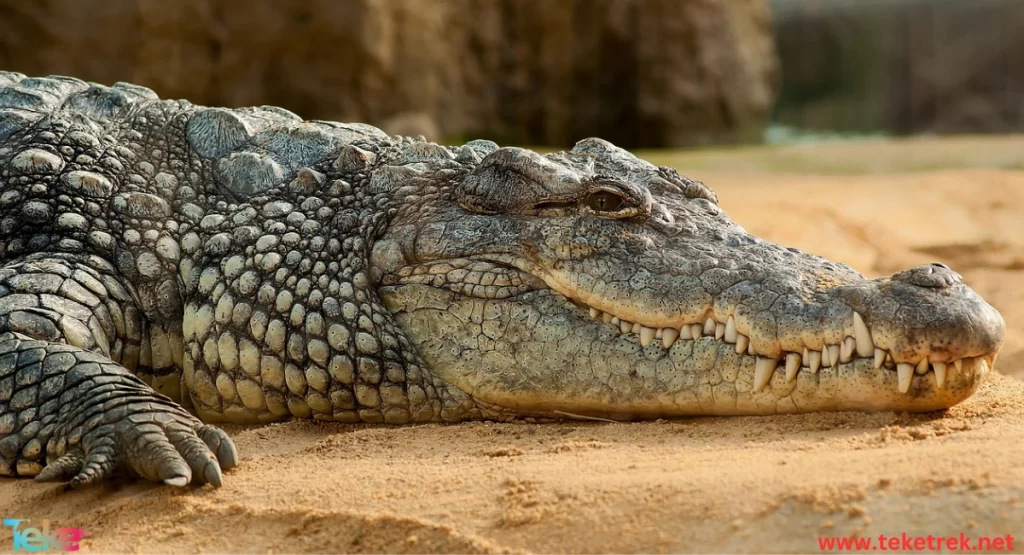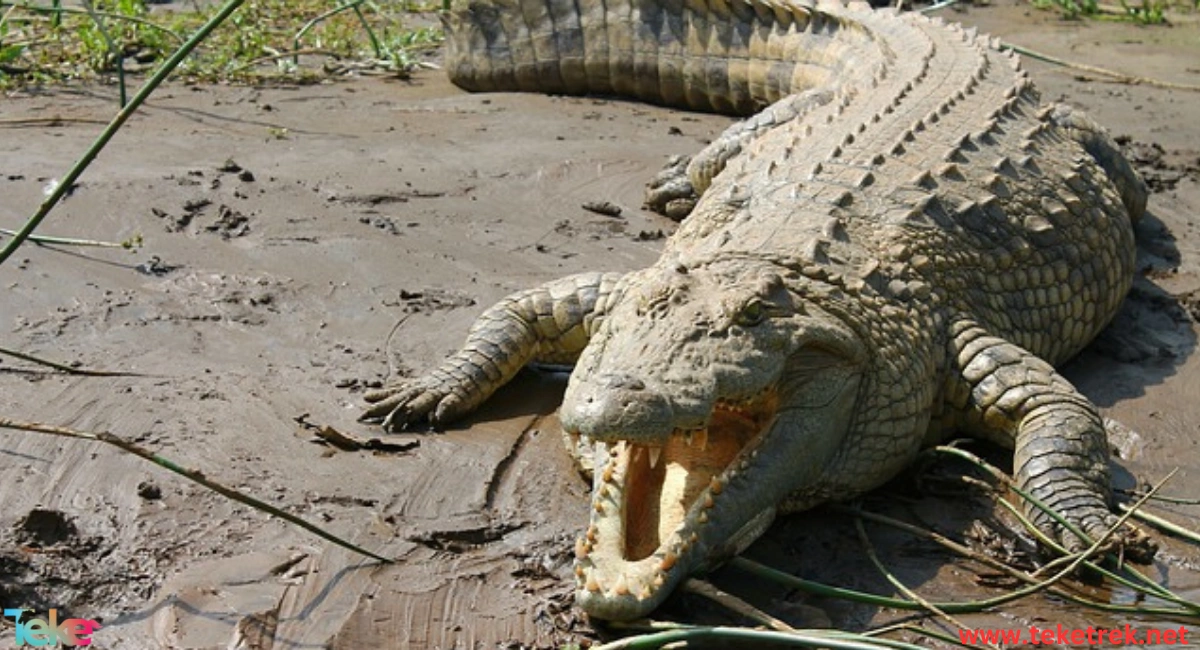The Nile crocodile is considered the second largest reptile on this earth after the saltwater crocodile. It is one of the most dangerous crocodiles, responsible for many human deaths every year. In addition to attacking almost any animal within its range.
Nile crocodiles are very social crocodiles, sharing basking in large patches.

Nile crocodile specifications
- Length and size:
It is considered the second largest reptile, as the average length of the Nile crocodile ranges between 4.1 meters and 5 meters and weighs about 220 – 750 kg.
- the color:
It is multi-colored gray or brown, and there are dark bands on the tail and body.
- Skin:
They have thick, heavily armored skin scales.
- Legs and tail:
It also has short legs, splayed legs, a powerful tail, and very powerful jaws. Their back feet are webbed, which makes them excellent swimmers.
They also have thin membranes to protect their eyes and tear glands that clean the eyes with tears.
- Head, eyes and ears:
The eyes and ears are located on the top of the head, which allows it to remain hidden underwater to escape from its enemies.
- the mouth:
The Nile crocodile has an elongated jaw with conical teeth.
Amazing facts about the Nile crocodile
- The Nile crocodile’s eyes have third eyelids that protect them during deep water diving.
- The crocodile can eat food while submerged in water, and the bone chips in the throat help it, and it also helps it if its jaw is open under water.
- If the ears of a Nile crocodile are immersed in water, water will not enter them due to the skin flakes closed in them.
- The Nile crocodile changes its location when temperatures change. It basks in the sun at the beginning of the day, then gets up and basks in the shade in the middle of the day.
- If the Nile crocodile feels angry or upset, it runs very quickly on land.
- Nile crocodiles have the strongest bites on the face of the earth, as their bite is 15 times stronger than that of a shark.
- Nile crocodiles swallow many stones inside their intestines, which helps them achieve balance in their body.
- Crocodiles carry their babies inside their jaws in an amazing way and guard them in shallow water.
- The sex of baby crocodiles is determined by the temperatures at which the eggs are incubated. At a temperature of 30 degrees Celsius, most of them are females, while at a temperature of 31 degrees they are mixed, and when it is 32 degrees or above, most of them are males.
- Although they can live on land, crocodiles are more flexible in the water and their movements are more fluid.
- It makes demands and is constantly replaced to grow for life.
- Because it prevents it from being killed with one bite.
Where does the Nile crocodile live?
- It is widely spread in sub-Saharan Africa, where it is found in the central, eastern and southern parts.
- It sometimes inhabits lakes and sedimentary deltas, and sometimes near the shores of the Nile, as it extends along the Nile River until it reaches the Nile Delta.
What does the Nile crocodile eat?
- The crocodile’s diet is irregular and random, as it does not distinguish the target, the prey, or even the type of prey.
- Nile crocodiles feed on some small animals such as fish and birds. It also attacks large animals and humans and poses a great danger to their lives.
- Crocodiles return to land in groups to search for prey, and the distances they travel may reach hundreds of meters away from water, and this depends on their large bodies, as well as their tails.
Reproduction among Nile crocodiles
- Nile crocodiles begin the breeding season when their individuals reach sexual maturity. This stage occurs when the male reaches 3 meters in length and the female reaches 2 meters in length.
- One of the courtship activities carried out by male Nile crocodiles is hitting their noses and tails in the water and raising their heads and chests to show off their bodies.
- After fertilization is complete, the females retain the eggs and sperm and continue to retain them until they find the appropriate conditions for building a nest, where they dig a nest and place the eggs in the hole.
- The male and female take turns preserving and protecting the eggs for a period of up to three months, and then the mother takes care of the young for many years


FAQ
- Is the Nile crocodile endangered?
Yes, the Nile crocodile is an endangered animal.
- Are Nile crocodiles aggressive?
Yes, some species of Nile crocodiles are very dangerous.
- Do Nile crocodiles eat sharks?
Yes, Nile crocodile may eat some types of fish such as bull fish.
In conclusion
In conclusion, Nile crocodiles are carnivores, and they usually hunt in the evening and at night. This crocodile can eat half its body weight. One of the threats to which this crocodile is exposed is the loss of habitat due to land development. In addition, it sometimes gets entangled in commercial fishing nets and dies.







Your point of view caught my eye and was very interesting. Thanks. I have a question for you.
Thank you